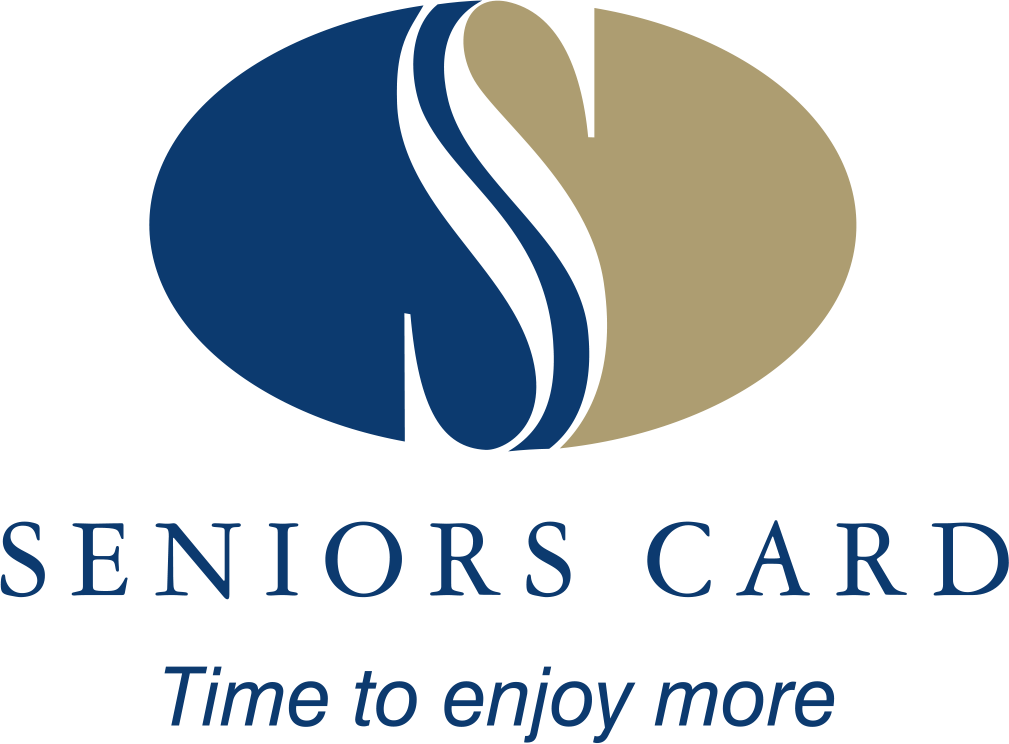They’ve both achieved enormous success on a global scale based overseas: he as an award-winning artist and theatre designer and she as a high-flying theatre executive. But Mark Thompson and Kerry Comerford now call Watervale home, combining their artistic pursuits with running a bed and breakfast on their idyllic property.
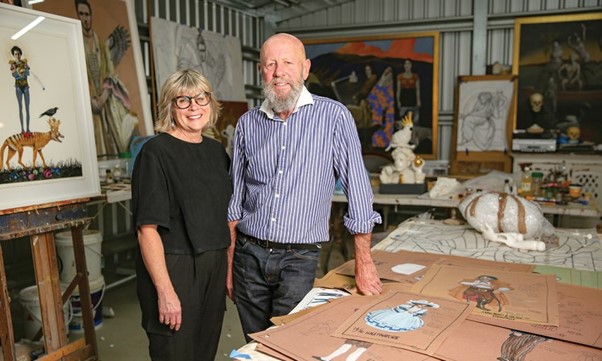
Kerry and Mark in his art studio shed, which sits at the back of the property.
From the outside it looks like many of the beautiful country properties in the Clare Valley – a rustic stone homestead surrounded by a pretty garden and acres of rolling green hills.
But step inside the home of Mark Thompson and Kerry Comerford and it becomes clear that this is no ordinary country cottage.
To walk through this house is to be transported to a high-end art gallery that showcases a huge collection of paintings, sculptures, photographs, antiques, stained-glass and other assorted artefacts, and artworks all beautifully displayed on every available wall and flat surface.
Many of the exotic pieces have been collected during the couple’s worldwide travels, particularly to Asia, where they’ve been visiting since 1997.
“The Asian works all have a memory, of acquisition, of time and place,” says Mark. “Some are merely tourist works, others are sublimely subtle in their presence and provenance. The personal votive objects are perhaps the most subtly poignant.
“Every small bronze, every ceramic bowl is a reminder of a trek through a market or back alley.”
A very large presence in the house is a life-sized ceramic woman called “Bertha”, an 18th century teary Saint, bought from an Adelaide antique dealer on North Terrace decades ago.
There are also works by local artists Annette Bezor and Christopher Orchard, whom Mark describes as “Adelaide art touchstones – both pursuers of the unattainable; both brilliant art makers”.
But Mark himself is an “Adelaide art touchstone” and, at 73, remains one of Australia’s most respected ceramicists and painters.
“We have a ragtag collection of treasures and castoffs in this house, the good stuff is by others, mine is just, there,” he muses.
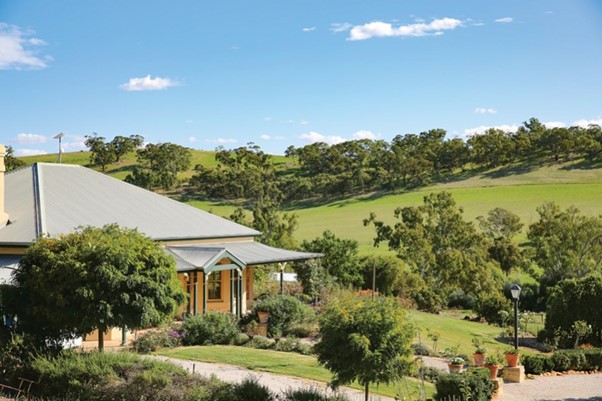
Kerry and Mark’s home is surrounded by greenery in this peaceful patch of Watervale.
Many of the artworks in the house – including the striking bespoke stained-glass windows – are Mark’s creations, and today he works from a large shed/studio on this beautiful slice of Watervale life.
When we visit, some of Mark’s half-finished works, including a ceramic woman from the waist up and another set of moulded arms and hands, sit on the bench in his studio, eerily beckoning visitors into the creative space.
Skulls and mortality have been recurring themes in Mark’s striking work, as has gold, all referenced in both his ceramic and painting artistry.
“I’m accompanied in my shed/studio by two people past,” he says. “A fully articulated real bone skeleton and an older skull. Both silent, eloquent reminders of the need to hurry to make marks.”
This remarkable artist is also a former Archibald Prize finalist and his large-scale portraits and whimsical sculptures fetch thousands of dollars globally.
One of his ceramic creations hangs in the kitchen, a boy with no name, of which Mark says: “He’s also a constant memory, a reminder of the transience of youth, eyes cast downwards and silent, grasping a fallen feather”.
Describing his ceramic work as “totally non-functional and purely decorative”, Mark explains that while his pieces are popular with Australian collectors, there has also been international interest over the years.
“Elton John bought a couple of pieces from my Sydney showing many years ago,” he says. “I did a whole lot of near life-sized standing porcelain babies with these weird gold and silver attachments.”
The human image is a predominant theme in Mark’s work, evidenced by the number of portraits and nudes hanging throughout the house. Kerry has often found herself the muse and a large nude (“one of many works, mainly clothed”, Mark says), hangs at the end of the hallway. Titled Tea and a Kookaburra, it was painted for a competition called “The Naked and The Nude” at the Manning Art Gallery in NSW.
As well as creating this extraordinary body of work over many decades, Mark has another entire career: as one of the country’s most revered theatre and costume designers.
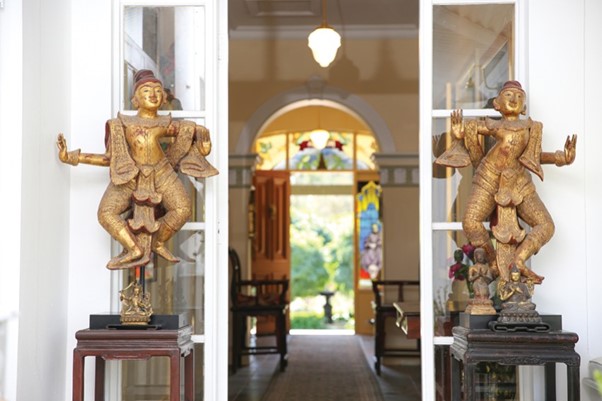
The house is full of artworks collected during the couple’s travels through Asia.
He has designed more than 60 productions for Australia’s leading theatre companies including Sydney Theatre Company, Opera Australia, The State Opera of South Australia and Australian Dance Theatre, having worked in the field since the mid-1980s.
Cross-dressing features in many of Mark’s paintings (referencing his time as a costume designer) and a large painting of a man wearing a period costume titled Man in the Yellow Dress stares down from the living room walls.
“I was just intrigued with that kind of notion of a masculine male in a yellow dress with some dressmaking scissors. The rest has swished on,” he says.
“The notion of exploring period cross-dressing is drawn from a very early State Opera of South Australian production of Macbeth. I dressed the actor Nick Hope in a topless metallic silver lame crinoline, he did the rest.
“That single production provided a way into exploring the masculine, attired in period costume. Not meaning to be prescient but wanting to explore the slightly perverse.”
So, how did these creative high flyers who could live anywhere in the world find themselves living in Watervale in the Clare Valley, running a bed and breakfast called Battunga?
The answer leads back to Kerry’s equally successful career in the arts and entertainment industries.
Prior to the move to South Australia, Kerry was vice president of Andrew Lloyd Webber’s Really Useful Group for the Asia Pacific region, where she has overseen the production and delivery of huge musicals such as CATS into the Asian market.
“When I started with the Really Useful Group, I would go into our new markets such as Korea where there was a lot of work to do in helping their companies understand the processes, auditioning casts and finding and training crews,” says Kerry, who started with the musical production company in 1996.
“So, I was executive producer and then general manager overseeing everything, and then I became vice president.
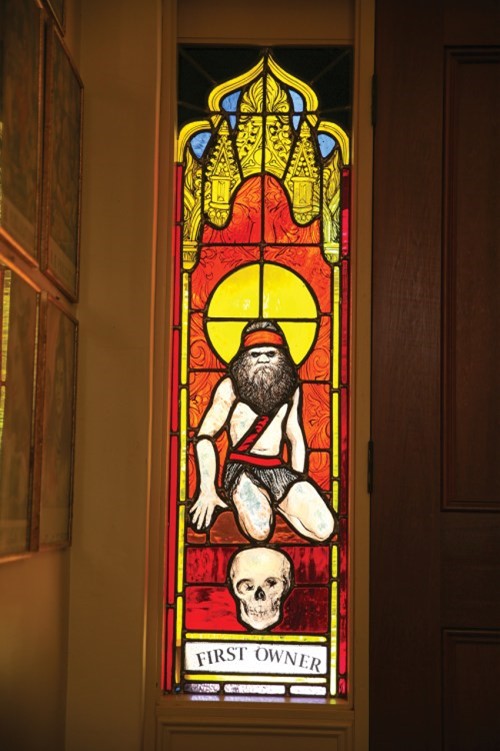
Mark handcrafted the stained-glass windows and doors around the house, this one depicting the Indigenous first owners.
“I met Andrew Lloyd Webber on some of my business trips to London. He is very passionate and always coming up with new ways to revitalise the works, as well as developing new ideas. I’m a huge musical theatre fan, which is how I ended up with the job, but I loved it and did it for 24 years.” The demands of both careers meant that Mark and Kerry, despite being together for 36 years, had not really lived together on any permanent basis.
For the past 10 years, Mark has been based at the couple’s rural property in Lake Macquarie, NSW, while Kerry, who travelled a lot for work, lived in their Sydney home.
“Because we had so many projects (with the Very Useful Group) in so many locations like South Africa, Istanbul and Asia, I needed to be somewhere central, but there came a point where I woke up one morning and thought, ‘That’s enough, we have been apart for long enough’,” Kerry says.
Neither Kerry, who grew up in Sydney, nor Mark, who hails from Darwin, had ever even been to the Clare Valley prior to discovering this property, which consists of 86 acres with a large house as well as four 19th century bed and breakfast cottages. They first saw it online at the end of 2020 and bought it without having stepped foot on the place.
“We’ve lived in lots of places and with every property we’ve bought it’s happened in a weekend, not weeks or months,” Kerry says.
“So, our property sold in October 2020 and we were here by January 2021. Once you’ve made a commitment to do something you think, ‘Okay, even if it’s the wrong decision, we’ll make this work’. We always go in with that positive frame of mind.
“We had vaguely talked about doing something like a bed and breakfast when we looked at properties up north. I’d been on tourism boards in Sydney so I felt like I had some understanding of how the tourism industry works, but taking one on in the middle of Covid was another thing.”
Mark says: “Neither of us particularly like the cold and we agreed our next place would be somewhere I didn’t have to chop firewood or wear a jumper. I now own two chainsaws and a lot of cold weather gear.”
Kerry now runs the bed and breakfast, while remaining on a couple of arts boards including Circa Contemporary Circus based in Queensland, as well as maintaining some musical consulting work.
Being immersed in the arts has simply been a way of life for this creative couple who first met in Adelaide in the mid-1980s. Back then, Kerry was working in administration at Carclew and Mark was on the board.
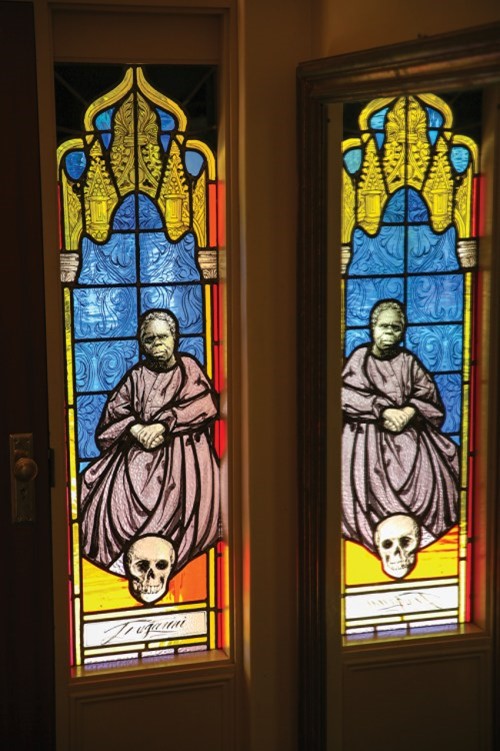
Kerry went on to work for many large arts organisations, gradually working her way up to senior positions including director of Tandanya National Aboriginal Culture Institute and entrepreneurial director at the Adelaide Festival Centre Trust in the mid-1990s.
Mark’s career has been diverse and dynamic, but always revolving around the arts.
He says, as a kid, he was good at art and by the time he finished school he thought teaching was his only option. So, he moved to Sydney where he lasted about five years before moving to Adelaide because “I knew that sex, drugs and rock ‘n’ roll were going to be the death of me,” he says.
He then discovered he could actually study art and so enrolled at the South Australian School of Art where he completed two diplomas, one in ceramics and one in painting.
Then came a lucky break: high-profile art dealer Kym Bonython discovered the talented young painter and took him under his wing.
“I was in my last year of art school and Kym Bonython was probably one of the biggest and most important gallery directors at the time,” Mark says. “He offered me a show in Sydney, so I had my first big show and I was sharing the limelight with Arthur Boyd who had a big show of paintings from London. I was in the upstairs gallery like a little hanger-oner.”
Mark admits that, with hindsight, he now realises the significance of being chosen for that exhibition which kick-started his career as an exhibiting artist.
“I showed with Kym a few times after that. He was probably one of the most important people in the country to take young artists under his wing and promote them,” he says.
“I then went back and did three years at a ceramics course with Milton Moon who basically taught me how to make pots, which I’ve then rejected, going off into my 3D non-functional ceramics.”
Mark admits he’s been lucky over the years when it comes to his career – a combination of being in the right place at the right time as well as connecting with inspiring mentors at critical career crossroads.
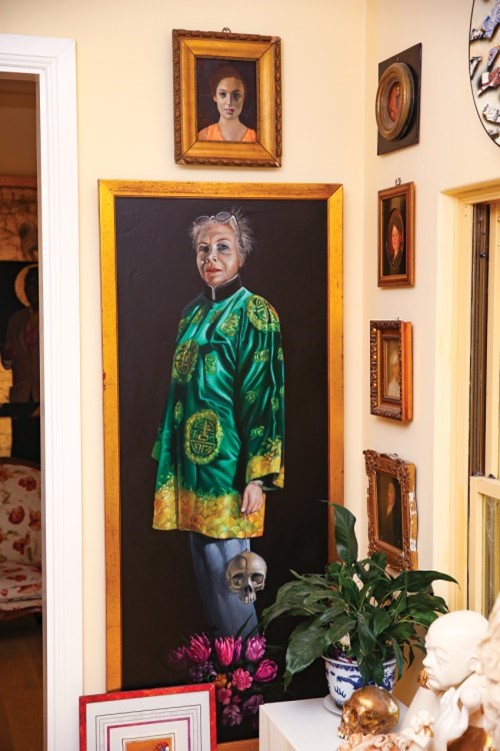
The portrait of Kerry, includes Mark’s signature use of skulls.
Somehow, almost organically, he has gone from one creative gig to the next for years.
“It’s never been a trajectory, it’s always been a series of some interesting events or some sort of happenstance that has occurred,” he says.
When Kym Bonython’s gallery was taken over by BMG Art gallery owner Trudyanne Brown, Mark says he hit a rough patch.
“I just stopped working,” he says. “I had a show booked with Trudy who had just taken over from Kym, rebranding everything, but I just dried up. By then I’d worked nine months a year on my own in the studio, not seeing people or working with anyone, then I’d see 200 people at opening night for three or four hours and then nothing again for months.
“I thought there’s got to be another way of working in the arts.”
Tenacious and gutsy, Mark then wrote letters to various arts organisations including State Theatre Company.
“I wrote and said, ‘I’d like to become a theatre designer’, which was totally audacious,” he says. “I wasn’t aware that NIDA actually trained people to be theatre designers and it was a four-year course. I just thought, ‘I can do that’, and I basically bullshitted.
“I then met with (theatre designer) Ken Wilby who took me under his wing and we became virtually inseparable, like twins. It got to the point where we’d finish each other’s sentences, we worked so closely together.
“We formed a design team in about 1984 and we ended up designing all of State Opera’s stuff for a couple of years. We made such pigs of ourselves designing nearly everything in town.”
Mark and Kerry, who were married in Adelaide in 1992, then moved to Perth where Mark became head of production and design at Western Australian Academy of Performing Arts (WAAPA), while Kerry got work running Perth’s Spare Parts Theatre and Deck Chair Theatre.
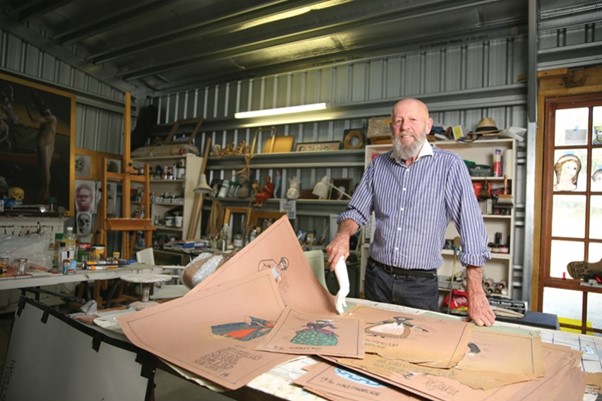
Mark in his art studio workshop, looking over some of his costume design drawings from years ago.
Mark admits that, despite having years of design experience, he had no formal training for his prestigious WAAPA role and, again, he found a colleague who led the way.
“I really had no knowledge of how a design department worked or how to train wardrobe people or lighting designers,” he says.
“I was shitting myself but then there was a lovely but mad head of the whole school Jeff Gibbs who took me under his wing and lied about how easy it would be.”
The WAAPA role lasted 18 months before Mark succumbed to being out of his depth. Then, a chance conversation with artistic director Rob Brookman saw the artist take on his next role, as designer of the Adelaide Festival.
“It’s funny how people do come along and rescue me,” says Mark, who was also in the creative design team for the opening and closing ceremonies for the DOHA Asian Games in 2006.
“I’d known Rob since I was in art school and he was at uni,” he says. “We had a clandestine deal going with the acquisition of LPs.
“We had always stayed in each other’s orbits. I was anxious to leave Perth and Rob had just been asked to direct the 1992 Adelaide Festival and he saw a way to expand the visual footprint of the event and asked if I wanted the gig. I jumped!
“It was a perfect thing, a big budget and no rules or precedence, it was all a risk, we wrote the book.”
Mark says no one had ever been engaged to tackle the “visual gestalt” of a Festival and his brief was to stamp this festival as “different”.
He did this through “RED”.
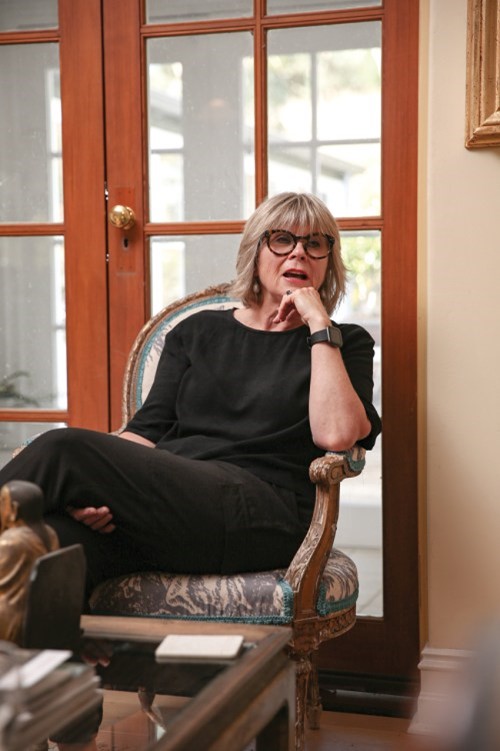
Kerry, at home in the couple’s living room, is enjoying a quieter pace after working for Andrew Lloyd Webber for many years.
“I swathed King William Road in hundreds of metres of red metallic lame,” he says. “The Festival Plaza was bedecked with more red lame fabric banners on 15-20 metre bamboo poles, trucked down from Queensland. The plaza looked like a Balinese village on a scarlet rampage.”
No matter where they’ve lived, Mark has also been very hands-on when it comes to home renovation. He and Kerry completely transformed their Lake Macquarie property turning an old home into a series of big white boxes, ultra-modern with polished concrete floors and four-metre-high ceilings and “plate glass for days”.
However, having done a few renovations, the couple admit they were looking for a house that needed no work when they eventually bought this place.
“Then, as soon as we walked in here, I started planning to knock out walls and I said, ‘the entire kitchen is coming out’,” Mark says.
“I kept saying, ‘these rooms look really tiny’, because we’d been used to our huge white rooms in Lake Macquarie.
“Nothing was white here, everything was cream or camel, we wanted to get rid of the cream.”
Today, the couple agrees the move to regional South Australia has been a success – they both love the peace and quiet of Watervale and Kerry says she particularly enjoys the changes of seasons.
“I can remember when we lived in Lake Macquarie thinking, is it ever not going to be 24 degrees?’,” she says. “It was wonderful but being surrounded by this much nature and seeing the change of seasons is just beautiful.”
With more time on her hands, the 64-year-old has also recently taken up yoga, as well as completing an Auslan course.
When Mark isn’t creating new works to exhibit (he exhibits about every 18 months), he is passionate about looking after their beautiful country garden and says he’s particularly enjoying the abundance of bird life.
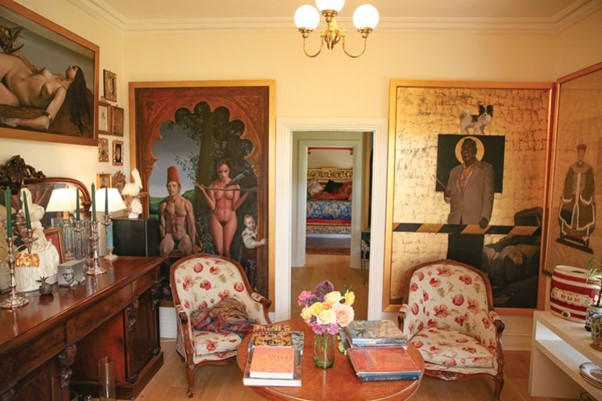
The couple’s home is wall-to-wall artworks, including these large paintings by Mark. The nude on the left is called The Peeper from Veronese’s Villa Barbaro, while the painting on the right is Elea Namatjira depicting Indigenous painter Albert Namatjira.
Together they are both gradually getting to know the Watervale community and say they have no plans for another major move…at this stage!
“It’s home because we get to make it into an environment that suits the locale yet embellished with the items that we have become attached to,” Mark says. “A lot are accidental and a lot are carefully curated and sourced, often associated with a current project.
“The peace and tranquillity of this particular part of the Clare Valley is profound; every sundown is spectacular across the Skilly Hills, the dirt track past the front gate, the sounds of the dozens of different types of birds and the call of lambs all blend to remind one of exactly how wonderful it is here.”
This article first appeared in the September 2023 issue of SALIFE magazine.
Words: Genevieve Meegan
Photos: Ben Kelly


